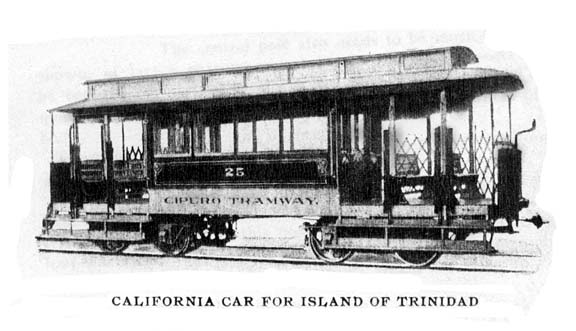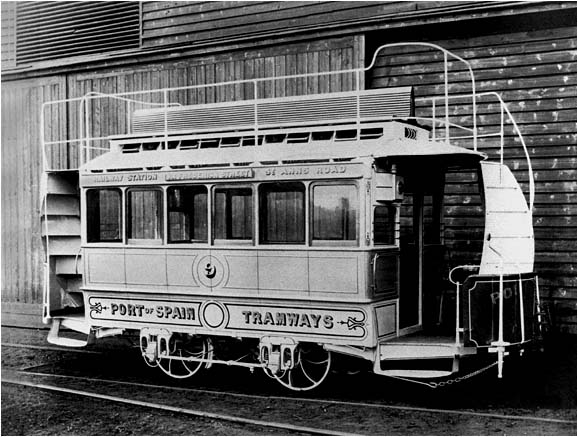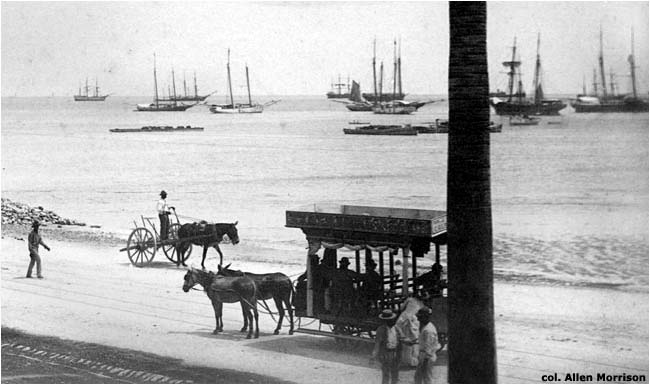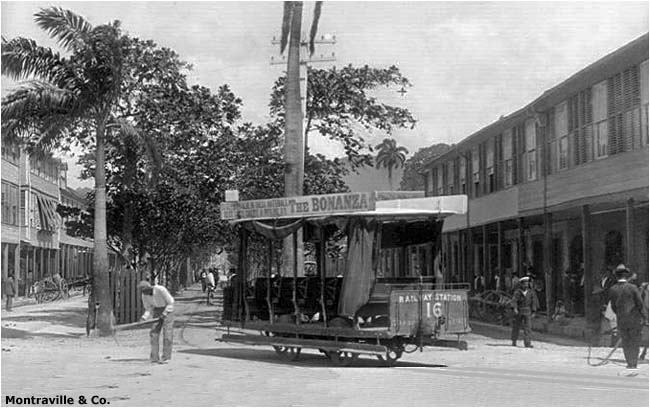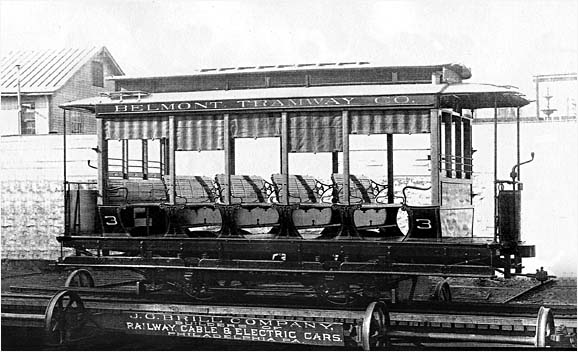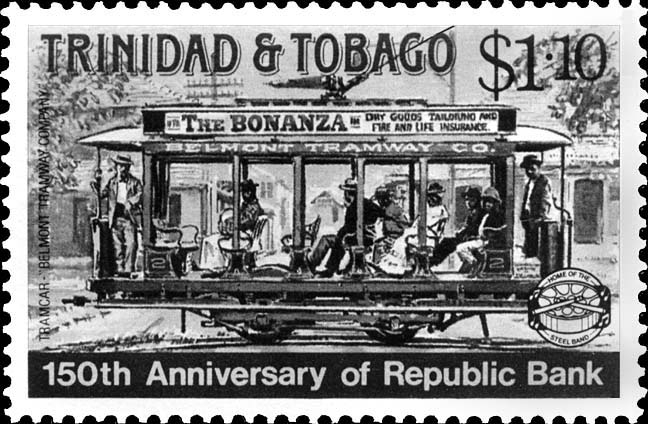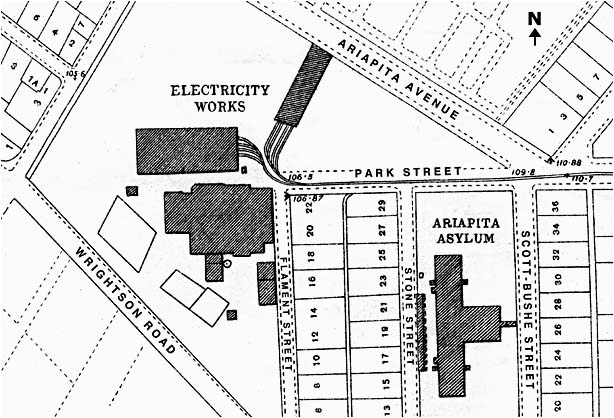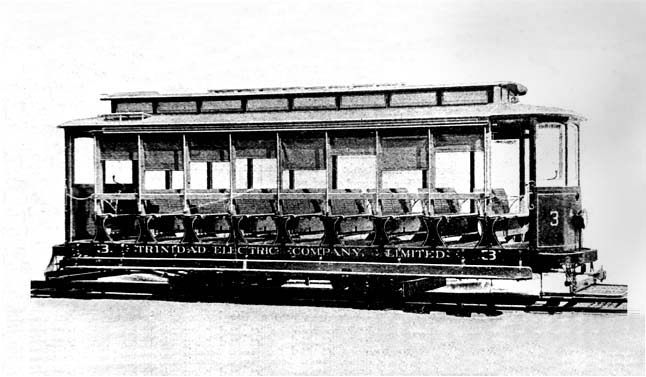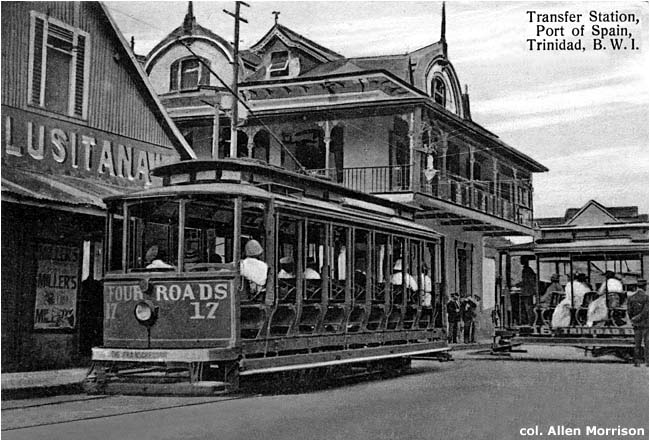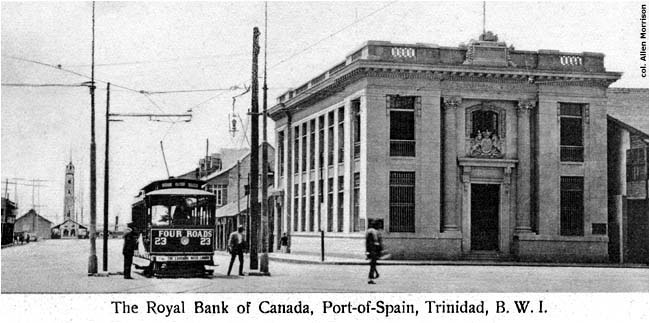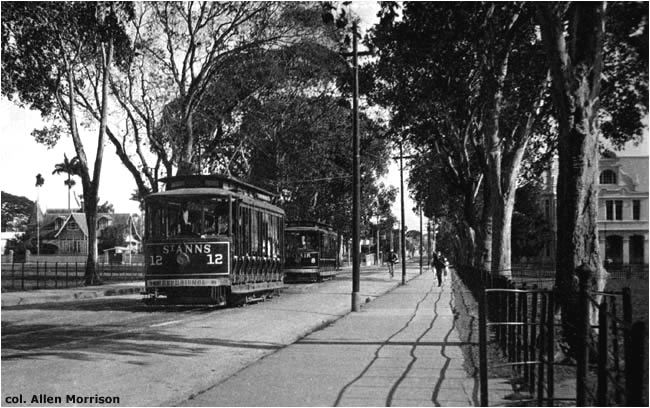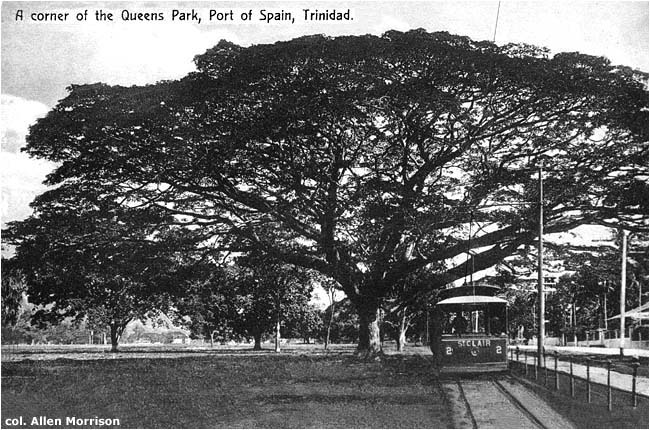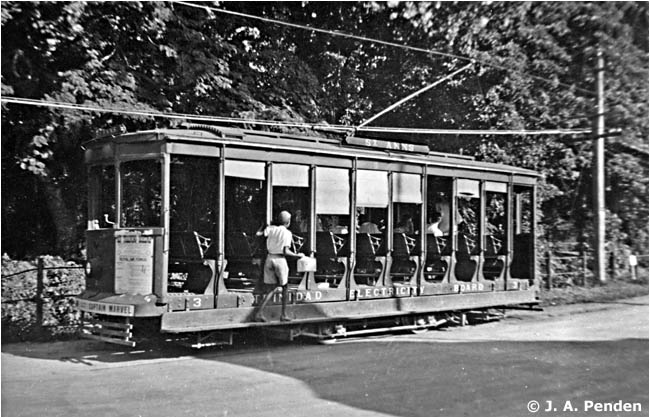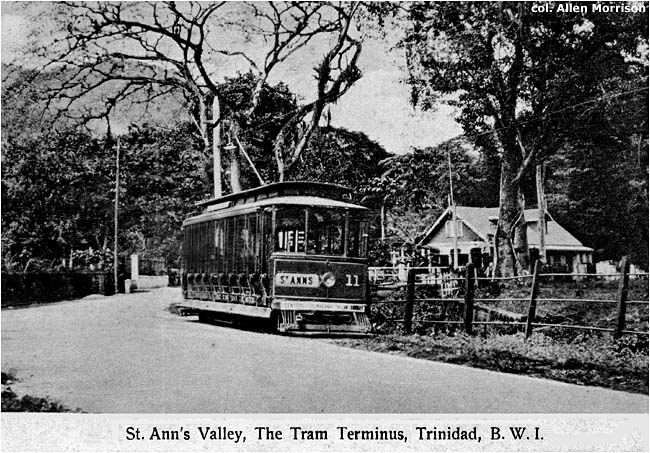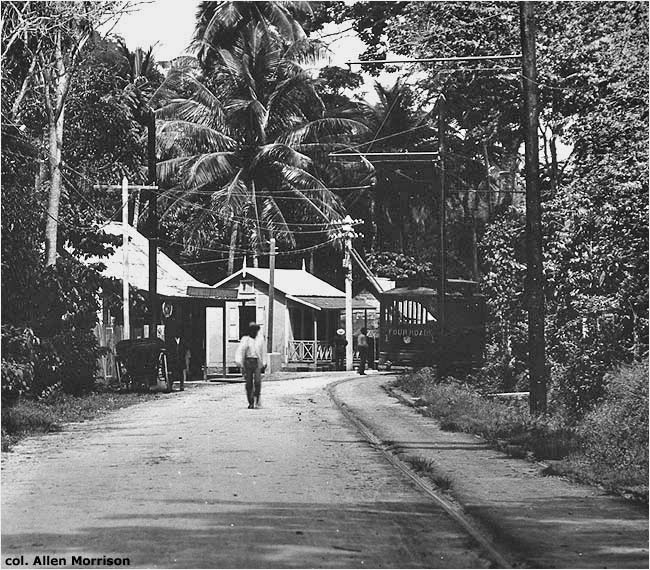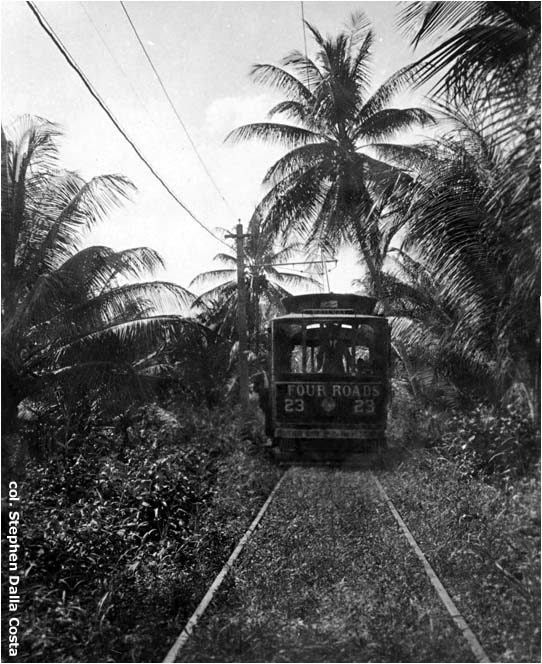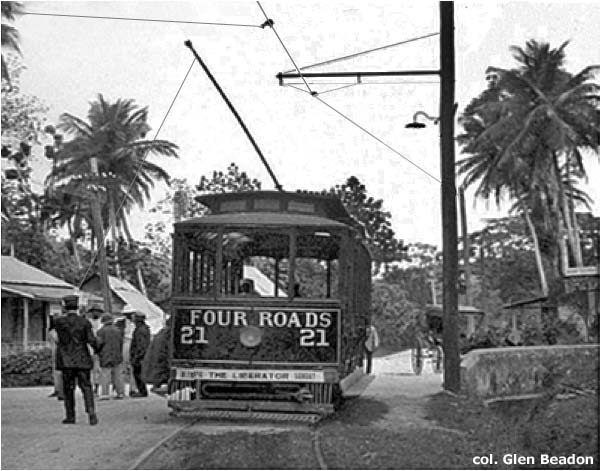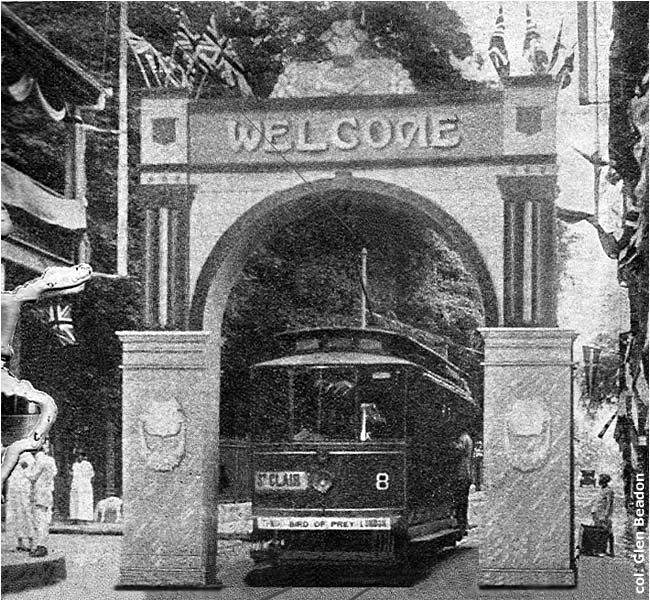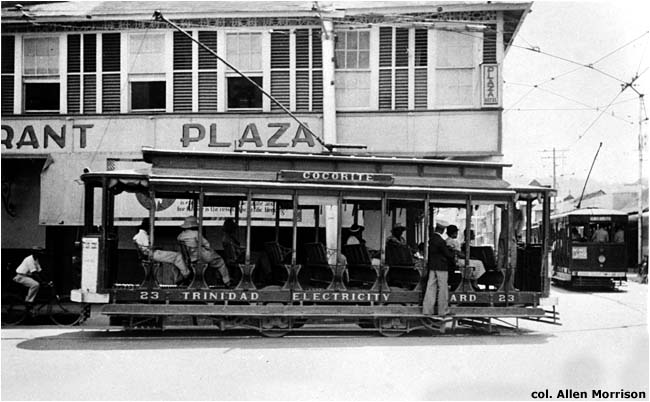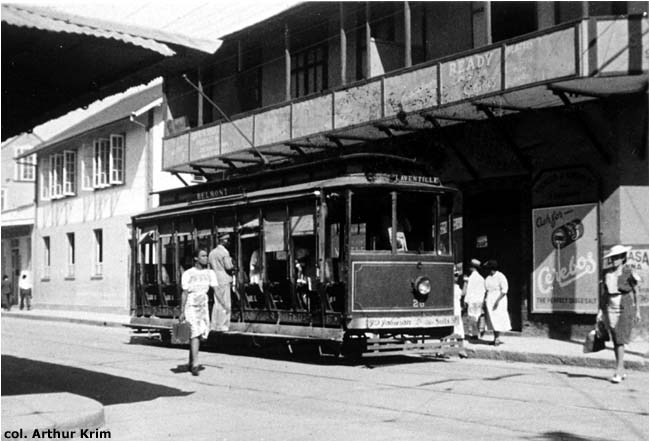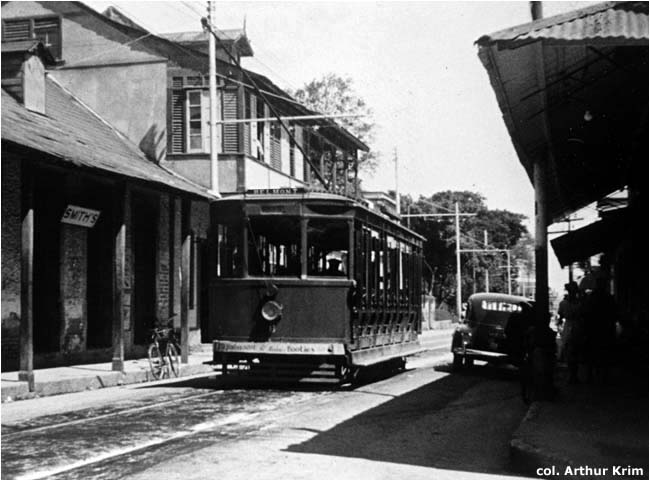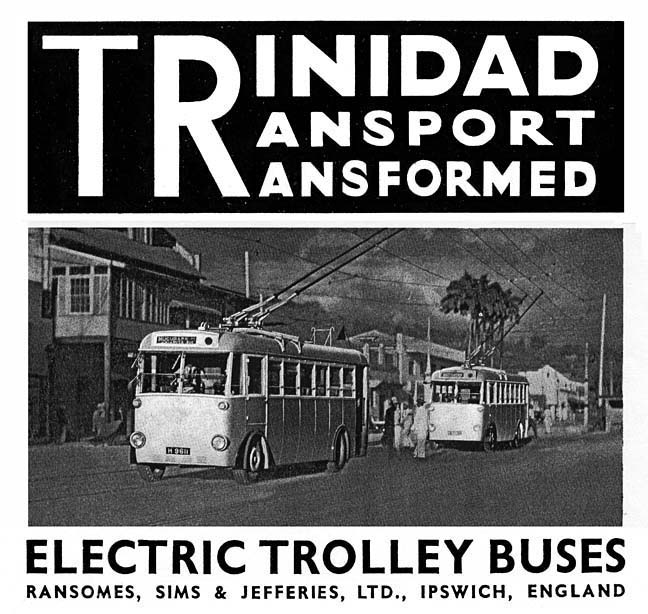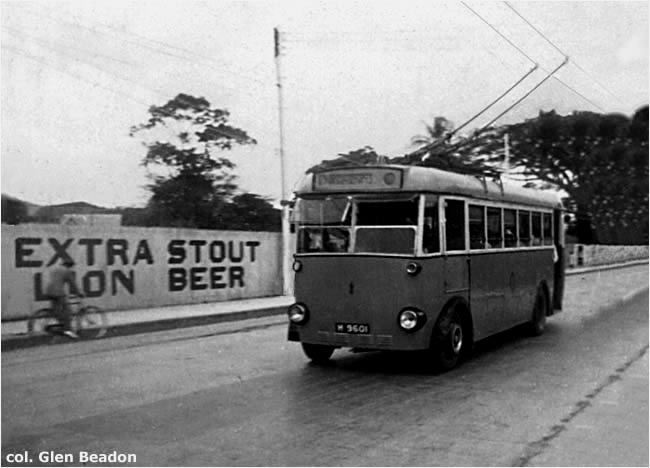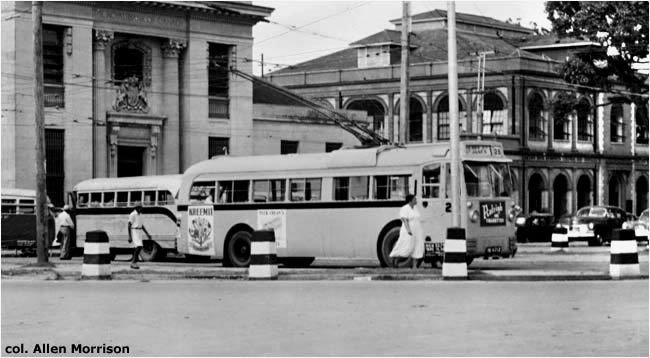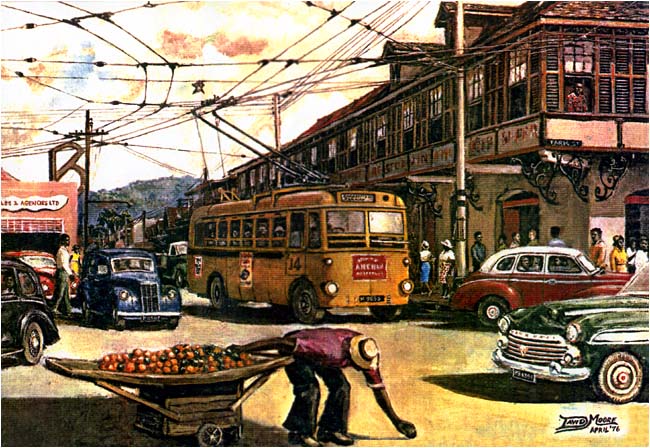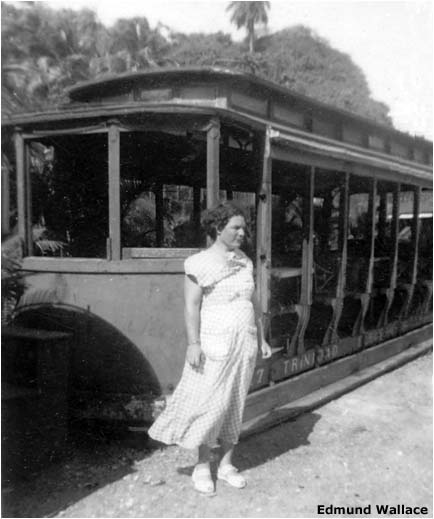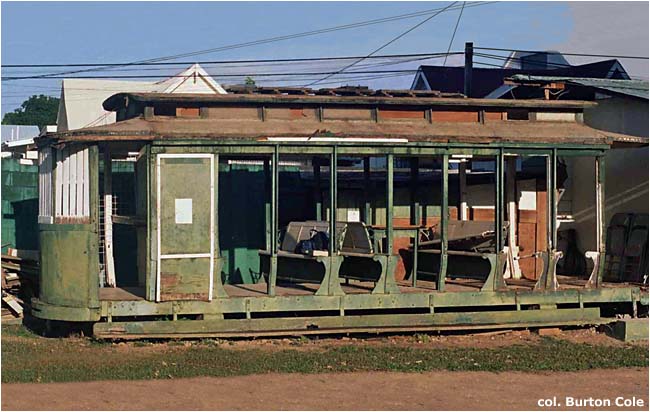The Trams and Trolleybuses of
Trinidad and Tobago are the southernmost islands of the Lesser Antilles [see area map]. The larger island, Trinidad, is about 40 miles wide and lies only 10 miles from the northeast coast of Venezuela. Discovered by Christopher Columbus in 1498 and claimed by Spain, the islands were acquired in 1797 by the British, who merged them as a single colony in 1889. Trinidad & Tobago achieved independence in 1962 and formed a republic in 1976. In the 20th century, oil has replaced sugar as the country's principal export.
(1) SAN FERNANDO There were no passenger railways on Tobago island. The first railway on Trinidad island was a horsedrawn line called the Cipero Tramway, which was built in the 1840s by a Scottish planter named William Eccles to transport produce from his sugar plantation to the wharf at San Fernando, 30 miles south of Port of Spain [see area map]. Tramcars began carrying passengers along the first four miles of the line, from San Fernando to Sainte Madeleine, on 5 March 1859. Steam locomotives replaced the animals and pulled the cars to Princes Town by 1864. San Fernando and Port of Spain were not connected by railroad until 1882. The origin of the 1859 rolling stock is unknown. No pictures of Cipero Tramway in operation have been found. The illustration below shows a vehicle built for the line in 1899 by American Car Company in St. Louis, USA. The term "California car" refers to the hybrid open/closed design [Street Railway Review, Chicago, 15 March 1902, p. 141]:
The Cipero Tramway was eventually absorbed by the Trinidad Government Railways system, which operated until 1968. TGR's last locomotive is displayed today on Harris Promenade in San Fernando. The right-of-way between San Fernando and Sainte Madeleine was called Tramway Avenue until recently, is now called Cipero Avenue.
(2) PORT OF SPAIN Trinidad's capital had a population of about 25,000 in 1876 when Trinidad Government Railways ran its first steam locomotive from Port of Spain to Arima, 14 miles to the east. In 1879 a New Yorker named Roblins or Rollins acquired permission to install a tramway on the capital's streets. The American constructed a depot and stables near the railway station and laid two routes to Queens's Park Savannah [see city map]. The Blue Tram went straight up Frederick Street. The Red Tram went via South Quay, St. Vincent Street and Cipriani Boulevard. Port of Spain Tramways started carrying passengers on 29 May 1883. The origin of its vehicles is uncertain. Tramcar number 9, shown in the undated photograph below, was built by Metropolitan Railway Carriage and Wagon Company in Birmingham, England, probably in the early 1880s [Metro-Cammell Archive, Birmingham Central Library]:
The existence of the photograph, however, is not proof that tram 9 ran in Port of Spain, or even left England. The photograph below – also undated but probably from about 1890 – shows a very different type of tram running along South Quay in Port of Spain [see city map]. It's too bad the photographer didn't notice the palm tree [col. Allen Morrison]:
Number 16 in the next view is turning from Broadway onto South Quay [see map]. (This section of Frederick Street was originally called Almond Walk.) The Railway Station is behind the photographer. The vehicle seems to be stranded, without passengers or horse [photo by Montraville & Co., collection Stephen Dalla Costa]:
Horsedrawn trams continued to run into the 20th century in Port of Spain, despite the arrival of electricity. There were two separate electric tram systems, of different track gauges and using different cars. Belmont Tramway Company began construction in 1893 and ordered three 6-bench open electric cars from J. G. Brill Company in Philadelphia on 1 October 1894. The photograph below was taken at the Brill factory before the vehicles were shipped to Trinidad [Brill Collection, Historical Society of Pennsylvania]:
Belmont Tramway tested an electric tram on 18 May 1895 and formally inaugurated electric streetcar service in Port of Spain the following 26 June. This was the fourth electric tramway constructed in Latin America, preceded only by lines in Nuevo Laredo (Mexico), Rio de Janeiro and Panama City (see chronology). The line ran from the railroad station ("Railway") up Frederick St. and along Queen's Park East [see map]. Track gauge is unknown but was said to be "narrow"; it was probably 42 inches. The only existing illustration of Port of Spain's first electric tramway was reproduced on a postage stamp in 1987 [col. Am]:
Belmont Tramway ordered another 6-bench car from Brill, numbered 4, in 1896. The Tramways Company of Trinidad, successor to Port of Spain Tramways, continued to operate horsedrawn trams throughout the city. Port of Spain's second electric tramway was built by Trinidad Electric Company, organized in Nova Scotia in 1900. In 1901 the Canadians purchased the Tramways Company of Trinidad, Belmont Tramway Company and the Trinidad Light & Power Company and built a tram depot and maintenance facility at the west end of Park Street. See map below [also see complete tramway map]. The structure fronting Ariapita Av. was later enlarged and used by trolleybuses [Trinidad & Tobago, Lands and Surveys Dept. Map "A.20.N", scale 1:2,500. Port of Spain, 1931]:
On 24 January 1902 Trinidad Electric ordered fifteen 9-bench open electric trams from J. G. Brill "for delivery by 10 June 1902" [Street Railway Journal, New York, 30 August 1902, p. 283]:
The new trams, numbered 1-15, were much larger than the vehicles that Brill had built for Belmont Tramway seven years before, and were distinguished by lack of bulkheads between the passenger and driver compartments. Trinidad Electric inaugurated Port of Spain's second electric tramway system in July 1902 (the precise date was not recorded). The rails of the new system were laid to standard 56 1/2 inch gauge, the same used by Trinidad Government Railways. The postcard view below shows two of the new cars meeting at Marine Square (today called Independence Square) at the foot of Frederick Street [see map]. Number 15 is about to turn left to allow number 8 to proceed north. Note that the route names are painted on the trams [col. AM]: |
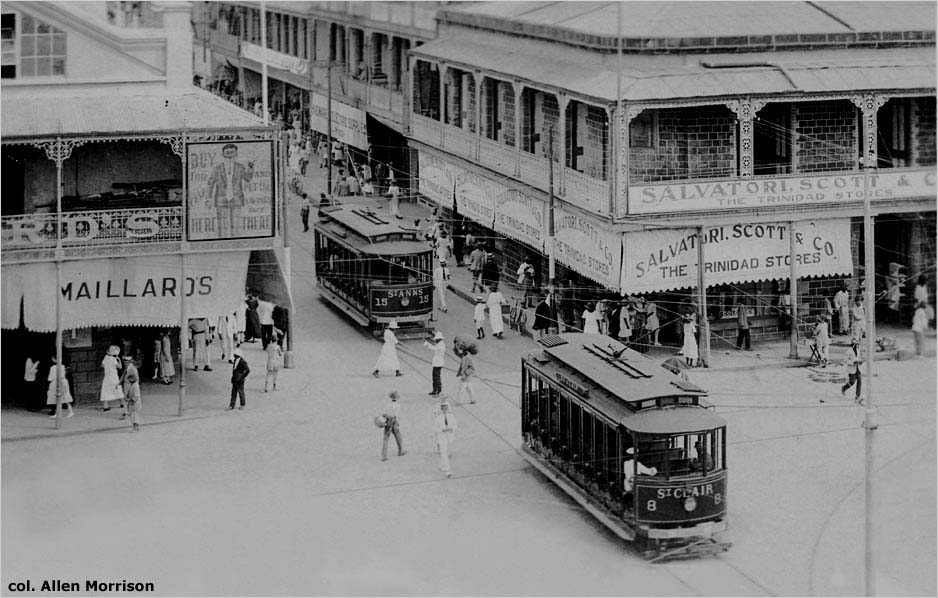
Trinidad Electric ordered five more similar cars from Brill in 1903, to be numbered 16-20, and another four in 1904, numbered 21-24. The four tram routes – Belmont, Four Roads, St. Clair and St. Ann's (usually written St. Anns) – all met at the Transfer Station at the corner of Park and Frederick Streets [see map] [postcard, col. AM]:
The postcard below shows one of the last cars built. View is south from Marine Square, toward the lighthouse on the harbor [see map]. The Railway station was next to the lighthouse [col. AM]:
Trams 12 and 8 are at the north end of Frederick Street, just below the Queen's Park Savannah [see map]. The building partly visible on the right is the National Museum [postcard, col. AM]:
|
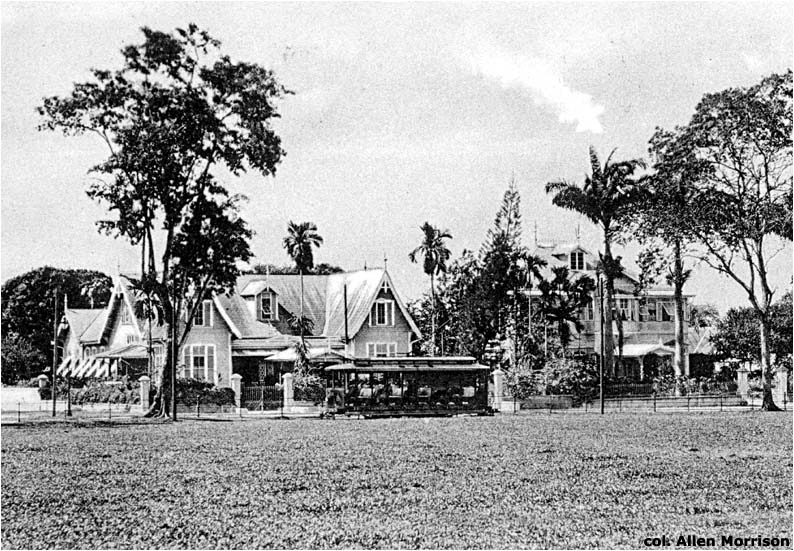
The huge saman tree shown on this postcard was a local landmark [col. AM]:
Tram 3, which has lost its clerestory, was photographed on St. Ann's Rd., just north of Queen's Park Savannah [see map] [J. A. Penden]:
Tram 11 at the end of St. Ann's Rd. [see map]. Apparently, at some point, wisely, Trinidad Electric gave up painting the route names on its cars [postcard. col. AM]:
The long Four Roads line served lower income neighborhoods on the west side of town [see map]. An extra fare was charged beyond Cocorite [postcard, col. AM]:
Toward the end of the Four Roads line there was a section of private right-of-way [see map] [col. Stephen Dalla Costa]:
Terminus of the Four Roads line. The conductor on the left is walking the trolley pole around to the other end of the car, to prepare for the return trip to town [col. Glen Beadon]:
Trinidad Electric opened a new line to Laventille in 1918 [see map]. The McGraw Electric Railway Directory published that year in New York noted 24 passenger motors trams running on 14 miles of track in Port of Spain. In 1920 a special arch was erected near Marine Square to honor the visit of His Royal Highness the Prince of Wales [Franklin's Year Book of Trinidad, 1921, col. Glen Beadon]:
The World Survey of Foreign Railways, published in Washington in 1933, reported 30 cars in Port of Spain. The origin of the six additional trams is unknown, but it is possible that the Canadian owners transferred equipment from the tramway that they also owned in nearby Georgetown, Guyana, which closed in 1930. The Trinidad government expropriated Trinidad Electric in 1937 and thereafter the tramway system was operated by the local Trinidad Electricity Board. TEB eliminated the tramway loop in Queen's Park Savannah and closed the Four Roads line beyond Cocorite. The photograph below was taken in 1941 at the corner of St. Vincent and Park Streets [see map]. Note the lopsided condition of tram 23 and the arch-roof tram, without clerestory, on the right [Langford Collection, Suffolk Record Office, Ipswich, England]:
This photograph of tram 26 was taken in the early 1940s, but the inscription "Trinidad Electric Company Limited" still appears along the floor board. Destination signs say "Belmont" and "Laventille" [col. Arthur Krim]:
Tram 8 signed "Belmont" has been rebuilt without clerestory. This is St. Vincent St. [see map] [col. Arthur Krim]:
On 12 December 1939 Trinidad Electricity Board ordered 14 trolleybuses from Ransomes, Sims & Jefferies in Ipswich, England. The vehicles arrived in 1940 and were numbered 1-14. TEB opened a trolleybus line along Mucurapo Road and Ariapita Avenue on 1 October 1941 [see map]. The photograph in the advertisement below was taken on South Quay, just east of the railroad station. Both vehicles are signed "Mucurapo Rd. / Ariapita Av." [Passenger Transport Journal, London, 12 June 1942, p. xxv]:
Here is an undated photograph of what appears to be Port of Spain trolleybus number 1. The location is uncertain, but this may be the eastern end of Av. Ariapita, opposite the trolleybus depot [see map]. The long word on the destination board is illegible, even when enlarged [col. Glen Beadon]:
In 1942 TEB acquired two more trolleybuses, numbered 15 and 16, that Ransomes had built for George Town, Malaysia, but could not be delivered there because of the Second War. (Actually there had been three trolleybuses, but one was lost at sea.) In 1943 TEB closed the Laventille tram line and ordered a second batch of 14 trolleybuses from Ransomes, which arrived in 1946-1947 and were numbered 17-30. The new vehicles, which had a somewhat different design, replaced trams on the Cocorite and Belmont lines, leaving trams in operation only to St. Clair and St. Ann's [see map]. Trolleybus number 28 shown below is signed "Henry St. / St. James". The scene is Marine Square [postcard, col. Allen Morrison]:
In 1976 Trinidad native David Moore painted this scene which recalled the trolleybus days of his youth. Note left-hand, English-style operation of both trolleybus and automobiles [David Moore]:
Port of Spain had the only trolleybuses in the western hemisphere that had doors on the left side and ran on the left side of two-way streets. TEB closed the St. Clair and St. Ann's tram lines on 31 March 1950, eliminating all tram operation in the city. However, it is said that, because of a tire shortage, the Belmont tram line was revived briefly in 1953 or 1954. All local transport was taken over in 1955 by City Transport Services, which closed the trolleybus system on the last day of 1956. The Port of Spain tramway may have been the last to operate on a Caribbean island. The tramway in Matanzas, the last to run in Cuba, closed in 1954; the Kingston, Jamaica, system closed in 1948; San Juan, Puerto Rico, in 1946; Port-au-Prince, Haiti, in 1932; Bridgetown, Barbados, in 1925; Willemstad, Curaçao, in 1920; and the tramway in St. Pierre, Martinique, as well as all the town's residents were wiped out by an eruption of Mount Pelée volcano in 1902. The electric tramway in Carúpano, Venezuela, only 100 miles west of Port of Spain, closed in 1933; and the system in Georgetown, Guyana, 300 miles down the coast of South America, closed in 1930. In 2010 former Trinidad resident Glen Beadon sent the following photograph of his grandmother standing next to Port of Spain tram 7, which had been discarded by the tramway company about 1952 and placed beside the sea at Carenage, a town 3 miles west of Cocorite [see map]. The photograph was taken about 1956 [Edmund Wallace, courtesy Glen Beadon; see Mr. Beadon's "Railway Biography"]:
Also in 2010, Trinidad resident Burton Cole sent the picture below of one of the original 1902 trams which he says "was being used as a club house at the St. James Tennis Club up to a few years ago"! The photograph was obviously taken before the vehicle was remodeled [col. Burton Cole]:
BIBLIOGRAPHY "California and Combination Cars: II" in Street Railway Review (Chicago), 15/3/1902, p. 141. Picture [reproduced on this webpage] and detailed description of tram number 25 built by American Car Co. for Cipero Tramway – but no mention of the quantity of vehicles supplied or anything else about the line. "Open Cars for West Indies" in Street Railway Journal (New York), 30/8/1902, p. 283. Description and photograph of tram number 3 [reproduced on this webpage] built by J. G. Brill Co. for Trinidad Electric Co. "Trinidad Electric Co., Ltd." in Moody's Manual (New York) of 1905, p. 1202. Financial data and description of company's activities. Algernon Aspinall. The Pocket Guide to the West Indies. New York, [various editions]. Itineraries of Port of Spain tram routes on p. 132 of the 1912 edition and p. 115 of the 1923 edition. The street maps in these editions do not show tram routes. But the street maps in later editions, e.g., 1931 and 1940, do show tram routes. The Mirror Almanack and General Commercial Directory of Trinidad and Tobago. Port of Spain, 1916. Timetable of the "Cepero Tramway". McGraw Electric Railway Directory (New York), [various editions]. Corporate history and brief data on operations of Trinidad Electric Co. Trinidad Hand Book. Port of Spain, 1924. "Tramways" section, pp. 124-125, describes routes. The 1931 edition shows similar on p. 119. Trinidad & Tobago. Lands and Surveys Dept. Topographical maps at scale 1:2,500. Port of Spain, 1931. Wonderful detail, including track layout, of the tramway system. Trinidad & Tobago. Lands and Surveys Dept. Sketch Map of Port of Spain, 1932. Street map shows tram lines (except extensions beyond town limits to Four Roads and Laventille). Trinidad & Tobago. Lands and Surveys Dept. Sketch Map of Port of Spain, 1954. Street map shows trolleybus lines. Henry Dow. The Trinidad and Tobago Year Book. Port of Spain, [various editions]. Detailed descriptions of tramway, omnibus and trolleybus routes on pp. 363-364 of 1945 edition, pp. 359-360 of 1949 edition, pp. 366-367 of 1950 edition, and p. 389 of 1956 edition. C. R. [Carlton Robert] Ottley. The Story of San Fernando. Port of Spain, 1971. "The Cipero Tramway" chapter on pp. 33-34 describes the development of the line. Michael Anthony. Profile Trinidad: A Historical Survey from the Discovery to 1900. London, 1975. Inauguration of the Belmont Tramway, pp. 185-186. Olga J. Mavrogordato. Voices in the Street. Port of Spain, 1977. Notes about tramways in both Port of Spain and San Fernando, pp. 55-58. Slight confusion of Belmont Tramway and Trinidad Electric. Old Trinidad 1948. This pleasant 3-minute film contains a 6-second sequence, between 1:35 and 1:41, which shows tram number 20 rounding the Queen's Park Savannah. In addition to the authors noted above, I wish to express my gratitude to the following persons for the information and illustrations that they provided: Harold E. Cox of Wilkes-Barre, John R. Stevens of New York, Arthur Krim of Boston, USA; Glen Beadon of Worcestershire, UK; and Jefferson McKell, David Moore, Burton Cole and Stephen Dalla Costa of Port of Spain, Trinidad & Tobago.
See my index of If you have comments, corrections or suggestions, This site was first uploaded on Copyright © 2008-2108 Allen Morrison |
